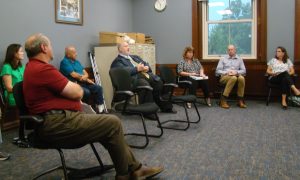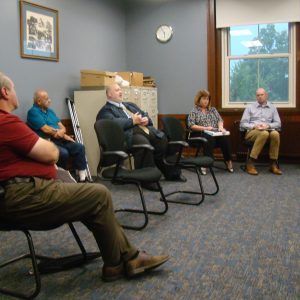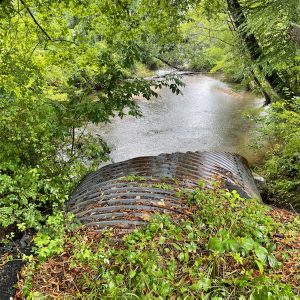WESTFIELD – The City Council Legislative & Ordinance Committee initiated a discussion of possible amendments to the city’s stormwater ordinance last night, identifying three areas where changes will be considered following a discussion among councilors, city officials and residents.
Ward 4 Councilor Mary O’Connell, who serves as the L&O recording secretary, summarized the issues at the conclusion of the 40-minute discussion, listing the areas of concern as the Department of Public Works Stormwater Management division accounting practices, the fee structure and credit issues recommended by the Pioneer Valley Planning Commission (PVPC.)
At-large Councilor Brent B. Bean III had requested the reconsideration of the existing stormwater ordinance, and the fee assessed to home and business property owners to fund the federally mandated program.
“I’ve heard from constituents who own four-family properties and who are paying at the nonresidential (commercial) rate while three-family property owners are paying on the residential rate,” Bean said. “It’s an arbitrary distinction that we made when we approved the ordinance. I’d like to see the four family go into the residential rate classification.”
The residential rate is a flat $20 per year, while the nonresidential rate is based upon the area of impervious surface, structures and paved lost, a rate of 4 1/2 cents per square foot, with a nonresidential minimum rate of $100 and a maximum rate of $640.
L&O Chairman Christopher Keefe questioned where that line between residential and nonresidential rates would end up.
“So if we move it for the four-family building, do the five-family property owners ask for it too?” Keefe asked, suggesting that a fairer rate structure, for both classes, would be based on square footage, but at a lower rate of a cent to a cent and a half per square foot.
Public Works Superintendent Jim Mulvenna said there is a total of 37 million square feet of impervious surfaces in the city and that the current residential rate is assessed to 11,303 property owners, while 886 are assessed the fee at the nonresidential rate, with 413 businesses assessed the maximum fee of $640 a year.
Mulvenna said the current structure generates $600,000 a year and his stormwater budget accounts for $585,000 of that total, with about $250,000 dedicated to the salaries and benefits of the five employees in that division of the Department of Public Works.
“That leaves about $300,000 for projects,” Mulvenna said. “There is $95,000 in the construction account, and $80,0000 for street sweeping with a private contractor. We have a catch-basin cleaning truck that cost $300,000 on a lease of $60,000 a year.”
James Parker, a Honey Pot Road resident, questioned Mulvenna as to why the funding for the salaries of the stormwater division employees was not transferred from the DPW budget when the division was established.
“That fee was established so the city could do 36 stormwater projects identified in 1996,” Parker said. “The purpose of the fee, objective of the program, is to correct those outfall problems identified in the report.”
Mulvenna said that the division was created during a year when his budget was cut by about $200,000, leaving him the choice of transferring the salaries into the stormwater account or laying off employees.
Parker asked Mulvenna if the city has a priority of projects.
“We’ve done some projects,” Mulvenna said, referencing a Shaker Road project done last summer. “We’re doing the best we can, slowly but surely” with the limited funding available.
Water Resource Superintendent Dave Billips said that his department used to perform the stormwater functions before they were transferred to the Public Works Department.
“Jim (Mulvenna) got this a couple of years ago, starting a new program that is underfunded and understaffed, started because of an unfunded federal mandate.” Billips said. “It takes a while to get it up and running.”
Parker also questioned if the stormwater division employees perform traditional Public Works duties as well.
Mulvenna said that during the winter months, when they cannot perform stormwater functions, those employee are used to plow and do DPW duties, but that there is also cross-over of DPW employees doing stormwater functions during the stormwater season of April to November.
“We’re paying for things that have nothing to do with stormwater (management) out of that fee,” Parker said. “Why not a charging back to the department for those (non-stormwater activities) so we know that the fee is being used for what it was intended?”
Keefe agreed with Parker’s point that there has to be better accounting between the two divisions since the stormwater division is funded through the fee account which could be audited by the federal Environmental Protection Agency.
“Moving forward, that has to be addressed because I think it will be an issue,” Keefe said. “We have to cover our backs if there is an audit.”
Parker also raised the issue of the credit system recommended by the PVPC for residents and businesses who take steps to reduce the flow of stormwater off their properties. The Planning Board requires commercial developers install systems to infiltrate water into the ground so that the volume of stormwater flowing off the site is no greater that the volume of the undeveloped site.
Parker said that if residents have financial incentive to install systems to retain stormwater on their property, there would be greater participation by residents.
At-large Councilor John J. Beltrandi II said that new subdivisions are also required to install systems to retain and infiltrate stormwater, but that residents, who pay fees to homeowner associations to maintain those systems, are also required to pay the city’s stormwater fee.
“It’s double jeopardy,” Beltrandi said. “They have to pay to maintain those systems (in subdivisions) but still have to pay the city’s fee. There should be some consideration of the money spent up front to keep stormwater on the site.”
Mulvenna said that nonresidential property owners have an abatement process, up to 30 percent of their fee, based on the installation of stormwater management systems required by the Planning Board.







